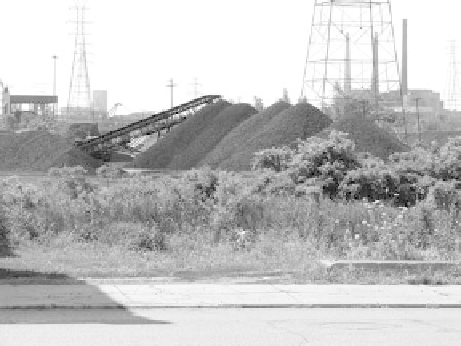Environmental Engineering Reference
In-Depth Information
coal-fired power plants, this was not the case. In fact, relatively modest levels of arsenic
were present in both surface and subsurface soils across all three land use categories and
all soils with the exception of the silty clay. The distribution of arsenic within the water-
shed may thus result from localized industrial sources of arsenic and conditions that serve
to increase its mobility. These conditions include an adequately high concentration, a pH
greater than 7, and the oxidation state of the arsenic. For example, As [V] is the dominant
form of arsenic under aerobic conditions found in the near-surface soils. In this oxidized
state arsenic will strongly bind with soil and sediment, particularly in clay-rich soils. In an
anaerobic environment, conditions associated with the subsurface clay-rich soils, arsenic
generally forms insoluble and nonmobile sulfides. However, in soils with a pH greater
than 7, arsenic tends to bind less strongly to soil particles and becomes more mobile. As
an example, residential soils in the Delray community of southwest Detroit have arse-
nic concentrations 10 times higher than other locations in southeast Michigan. One likely
cause of this high arsenic concentration is the neighborhood's proximity to Zug Island, an
industrial complex with a long history of steel manufacturing fueled by the burning of
coal (Figure 9.2) (Peterman and Murray 2010).
The silty clay unit also contains substantially higher levels of barium, cadmium, lead,
and zinc than any of the other soils units. Because the silty clay is located in the more
industrialized part of the watershed, the higher concentration of these metals suggests
anthropogenic sources. This premise is supported by the data presented in Table 9.5,
which indicates almost uniformly higher metal concentrations in industrial land uses in
both surface and subsurface soils. Two notable exceptions were the high lead and mercury
levels present in residential areas in the surface and shallow subsurface soils, respectively.
Lead in the surface soils in residential areas was present at levels 16 times that found in the
lower clay layer. The high lead levels are most likely due to deposition of lead dust from
sources such as lead-based paints in older residences common in urban areas and the for-
mer use of leaded gasoline (Mielke et al. 1983; Mielke et al. 1984; Mielke 1999). Subsurface
lead concentrations in residential areas are also relatively high, with mean values at more
than twice the background levels found in the lower clay layer. Mean values of surface lead
in industrial areas are nearly as high as in residential areas (15.5 times background) with
FIGURE 9.2
Coal piles ready for combustion near a residential neighborhood in southwest Detroit, MI. (Photo by Kent
S. Murray.)

Search WWH ::

Custom Search